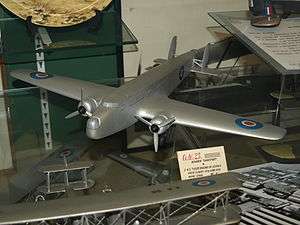Armstrong Whitworth A.W.23
| A.W.23 | |
|---|---|
 | |
| Model of A.W. 23 | |
| Role | Bomber/transport |
| Manufacturer | Armstrong Whitworth Aircraft |
| Designer | John Lloyd |
| First flight | 1935 |
| Retired | 1940 |
| Status | Destroyed |
| Primary users | Royal Air Force Flight Refuelling Ltd |
| Produced | 1935 |
| Number built | 1 |
| Developed into | Armstrong Whitworth Whitley |
The Armstrong Whitworth A.W.23 was a prototype bomber/transport aircraft produced to specification C.26/31 for the British Air Ministry by Armstrong Whitworth Aircraft. While it was not selected to meet this specification, it did form the basis of the later Armstrong Whitworth Whitley aircraft.
Design and development
Specification C.26/31 required a dual-purpose bomber/transport aircraft for service with the Royal Air Force (RAF), with the specification stressing the transport part of its role. The A.W.23 was designed by John Lloyd, chief designer of Armstrong Whitworth to meet this specification, competing with the Handley Page H.P.51 and the Bristol Bombay.
The A.W.23 was a low-wing twin-engine monoplane, powered by two Armstrong Siddeley Tiger engines. It had a fabric covered braced steel fuselage accommodating a large cabin to fulfill its primary transport role, but with room for internal bomb racks under the cabin floor. The aircraft's wings used a novel structure, patented by Armstrong Whitworth, which used a massive light alloy box-spar braced internally with steel tubes. This structure was extremely strong but required a thick wing section, increasing drag. This wing structure was re-used in Armstrong Whitworth's Whitley bomber. The A.W.23 was the first Armstrong Whitworth Aircraft to be fitted with a retractable undercarriage.[1][2]
A single prototype, K3585, was built first flying on 4 June 1935.[2] Owing to its unreliable Tiger engines, its delivery to the RAF for testing was delayed, with the Bombay being declared the winner of the specification.
The prototype was given the civil registration G-AFRX in May 1939 being used for inflight refuelling development by Flight Refuelling Ltd who used it with the Short Empire flying boat. It was used in February 1940 for the world's first night refuelling experiments. It was destroyed in a German bombing raid on Ford airfield in June 1940.[3]
Operators
Specifications (A.W.23)
Data from The British Bomber since 1914[2]
General characteristics
- Crew: 4
- Capacity: 24 troops
- Length: 80 ft 9 in (24.62 m)
- Wingspan: 88 ft 0 in (26.83 m)
- Height: 19 ft 6 in (5.95 m)
- Wing area: 1,308 ft² (122 m²)
- Loaded weight: 24,100 lb (11,000 kg)
- Powerplant: 2 × Armstrong Siddeley Tiger VI 14 cylinder Radial, 810 hp (604 kW) each
Performance
- Maximum speed: 140 kn (162 mph, 261 km/h) (TAS) at 6,500 ft
- Range: 690 nmi (790 mi, 1,270 km) (estimated)
- Service ceiling: 18,100 ft (5,520 m)
- Wing loading: 18.4 lb/ft² (90.2 kg/m²)
- Power/mass: 0.0672 hp/lb (0.11 W/kg)
- Climb to 10,000 ft (3048m): 10 min 50 s
Armament
- Guns: Provision for single machine guns in nose and tail turrets
- Bombs: provision for 2,000 lb (907 kg) bombs internally.
See also
- Related development
- Aircraft of comparable role, configuration and era
- Related lists
References
- Jackson, A.J. (1973). British Civil Aircraft since 1919 :Volume One. London: Putnam. ISBN 0-370-10006-9.
- Mason, Francis K (1994). The British Bomber since 1914. London: Putnam Aeronautical Books. ISBN 0-85177-861-5.
- Tapper, Oliver (1988). Armstrong Whitworth Aircraft since 1913. London: Putnam. ISBN 0-85177-826-7.
| Wikimedia Commons has media related to Armstrong Whitworth A.W.23. |